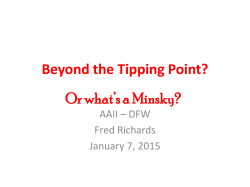
Document 424398
This publication is intended for intermediary use Johny Lambridis, Portfolio Manager at Prudential, explains some of the traditional pitfalls in the value style of investing as they apply to the South African equity market Given that a number of South Africa’s value managers have underperformed their peers in the ranking tables in recent years, quite a few articles have been written on “value investing” as an investment style. Some of these articles argue that value investing is dead, while others prophesise its impending return. Value investing defined What is value investing? At the heart of the value investing philosophy is the belief that equity markets are broadly efficient over the long term, but can be very inefficient over shorter periods. As a result, prices at times may not reflect the fundamental value of a company, providing an opportunity for long-term value investors to exploit these mispriced stocks. Value investors aim to identify shares that are trading below the estimate of their long-term fair value, based on measures like price-to-book ratio, dividend yield and price-to-earnings ratio. Share prices do not stay at unrealistically cheap levels indefinitely; over time, they should rise to reflect their fundamental value. Prudential certainly does not believe that value investing is dead. Nevertheless, every style has its drawbacks, including the possibility of periods of material underperformance, and it is therefore important to be aware of potential problems with value investing in South Africa. We certainly do not believe that value investing is dead. Nevertheless, every style has its drawbacks, including the possibility of periods of material underperformance, and it is therefore important to be aware of potential problems with value investing in South Africa. Many SA asset managers are value investors The first potential problem is that most asset managers in South Africa are “value-biased”. This is probably the result of the tremendous success in our lifetime of value icons like Warren Buffett, as well as global data that has accumulated over the years showing the superior performance of the value style versus other investment approaches over time. Value is therefore an over-crowded space locally which, combined with the limited number of companies listed on the JSE, makes it difficult for a single value manager to outperform other value peers. The risk arises that in order to differentiate themselves, certain value managers effectively become (or would be better characterised in other markets as) “deep value”, “contrarian value” or “cyclical value”. At the extreme, a manager struggling to differentiate its value style would buy under-valued, but also deeply under-owned stocks, hoping that a severe market dislocation would see its portfolio outperforming the broader market. Beware investing in declining industries Most institutional value managers in South Africa have no doubt read The Intelligent Investor by Benjamin Graham – the father of value investing. This brings us to the second (and most significant) potential problem – the risk of investing in declining industries. Is it possible that Graham is too quick to dismiss the thesis of Wharton Professors Mead and Grodinsky (alluded to by Graham in Chapter 6 of The Intelligent Investor)? The professors convincingly argue that once an industry has turned downward, companies in that industry should – with rare exception – be avoided. “Industries, the demand for whose products or services is declining, must be excluded from investment consideration. These industries, no matter what the inducements of yield and apparent security, the investor – as distinguished from the trader – should avoid. Unless and until these declining-industry corporations have applied the necessary correctives (and had they done so, many of them would not be in the declining group), the investor, if he desires security, should avoid them. Each one of these industries is in the grip of a deadly disease – declining demand – and it will be difficult to save any of them.” What makes the situation worse when applied to South Africa, in my opinion, is that some of the “necessary correctives” referred to in the above passage are not possible in many of our industries given: • A finite resource base for most extractive industries: at some point, no matter how deep the mines and advanced the technology; the amount of resources to be extracted will be too low to be economically viable. • Rigid labour laws and uncompromising unions: this makes reducing fixed expenses for declining businesses almost impossible. The ongoing strike in the Platinum industry is a recent stark example. • An overly forgiving shareholder base: management teams that have performed poorly by destroying value continue to be allowed to do so. It is therefore possible that certain companies that screen well on value metrics (as ascribed by Graham and others) may simply be in a declining industry from which it is difficult to emerge. These companies, which appear attractive for investors, but, in fact, have little chance of appreciating in value over time, are often termed “value traps”. This could well explain the number of value traps in the portfolios of certain South African value managers. Benchmark risk The third potential problem arises from the fact that many value managers are “benchmark agnostic”, but are measured by their clients (and the media) against a certain benchmark. With a “benchmark-agnostic” approach, the manager holds shares in his (or her) portfolio with little or no regard to the weight of these stocks in the benchmark (such as the FTSE/JSE All Share Index). Such an approach is highly recommended for long-term investors (such as Buffett and others) and for managers looking to outperform well-diversified benchmarks, such as those in developed markets. However, in South Africa, where our benchmarks are often highly concentrated in a number of large stocks, a benchmark-agnostic approach can lead to significant, often unintended risk of under (or out) performance. One way to explain “benchmark risk” is to use a rugby analogy. Springbok rugby coaches (the “asset managers”) tend to believe with the utmost conviction that they have the ability to pick the best 15 players (the “stocks”) to beat any team in the world (the “benchmarks”). However, the truly successful coaches, such as Kitch Christie and Jake White, understand intricately the team they are trying to beat. The strengths and weaknesses of the opposing team play an integral role in the selection of these coaches’ Springbok squads (recall the selection of James Small to neutralise Jonah Lomu in the victorious 1995 World Cup Final). When selecting your asset manager, make sure they understand “rugby”, but also the teams they have been hired to beat (if not the referee officiating). Portfolio managers should be cognisant of the highly concentrated benchmarks they aim to outperform. As a result, considerable time should be spent debating the weight of stocks and sectors relative to their benchmark weight (what is termed the active risk), as opposed to only their absolute weights in the portfolio. Equal consideration should be given to both the stocks held in the portfolio and those not held to ensure there are no unintended positions or unnecessary risk in the portfolio. The debate over gold shares The fourth and last potential problem – and probably the most controversial in the past two years or so – is the inclusion of gold shares in the portfolios of value managers. A thorough discussion of gold and gold shares is beyond the scope of this article. SA Gold Industry: Steadily Rising Costs Source: Prudential Suffice it to say that given the monetary expansion by the central banks of the developed world, gold (in the form of coins, bars and certain ETFs) has certain characteristics that may make it suitable for inclusion in an investment portfolio (low correlation with other assets, a store of value, an alternative currency, a finite supply of above- and below-ground stocks). However, the extension of this argument to a very large holding in South African gold shares (when their benchmark weight is only some 2%) is not immediately apparent, particularly when viewed through the lens of Mead and Grodinsky’s argument to avoid declining industries. At Prudential, we have avoided gold shares. The graphs show two of the many issues facing South African gold producers that have contributed to our decision to avoid gold shares. They clearly demonstrate how the industry as a whole has been faced with a combination of steadily rising costs and falling production (among other factors), which have eroded earnings over several years. SA Gold Industry: Falling Production Source: Prudential While Prudential’s approach is to invest in undervalued shares, we do have a bias towards investing in quality companies that have a track record of delivering real growth in the underlying equity invested in the business – we refer to these companies as value creators. This “quality value” approach ensures that portfolios are constructed that in aggregate trade at a discount to the market, but still have an ability to deliver underlying growth in dividends at a rate that is at least in-line or better than that of the market. This approach does not preclude a manager from investing in lowerquality companies, but a higher margin of safety (a much lower share price) should be demanded for the additional risk taken. In conclusion, value investing is likely to continue providing investors with relative outperformance over the long term, but understanding, and in certain cases allowing for, the potential problems with this investment style is crucial in attaining this outperformance. Glacier Research would like to thank Johny Lambridis for his contribution to this week’s Funds on Friday. Johny Lambridis holds a B EconSc (Actuarial Science) degree and is a Fellow of the Faculty of Actuaries. He is a Portfolio Manager and Equity Analyst focusing on the life assurers and specialist financial services companies. He is also a member of the Equity Voting Committee. He joined Prudential in 2013 and was previously an Equity Portfolio Manager and Analyst with another asset management group.
© Copyright 2025





















